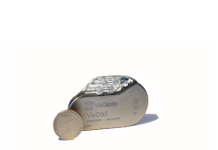Johnson & Johnson (NYSE:JNJ) has released results for its Embotrap stent retrievers showing the next-generation design’s success in removing blood clots from ischemic stroke patients.
Johnson & Johnson MedTech’s Cerenovus subsidiary tracked outcomes for 1,000 ischemic stroke patients who underwent mechanical thrombectomy procedures with Embotrap devices as a first-line therapy.
“The positive preliminary findings of this research provide real-world results that demonstrate advances are possible in mechanical thrombectomy procedures to treat ischemic stroke,” Cerenovus Worldwide President Mark Dickinson said in a news release. “It is encouraging to see these positive results and realize the impact this data can have on improved patient outcomes and changing the trajectory of stroke.”

Cerenovus said its EXCELLENT registry (which stands for “Embotrap extraction and clot evaluation and lesion evaluation for neurothrombectomy”) is the largest global acute ischemic stroke registry, dating back to 2018. The registry covers 36 sites worldwide.
More than 50% of the procedures were completed with a single pass of Embotrap, Cerenovus said. Nearly 95% of the patients ultimately achieved successful reperfusion, whether through the use of an Embotrap stent retriever or successive attempts using other devices or methods such as direct aspiration or co-aspiration.
Cerenovus also said Embotrap delivered first-pass substantial reperfusion or better in 63% of the cases, including near-complete reperfusion in 38% of the cases.
The study reported a good to ideal outcome in nearly 47% of patients. Cerenovus characterized the 1.6% rate of symptomatic complications as “very low.” The symptomatic complication rate was even lower, at 0.6%, in cases with a single pass of Embotrap.

“The EXCELLENT Registry study is representative of current practices because of its broad inclusion of acute ischemic stroke patients and use of mixed techniques. As a result, the findings are meaningful to advance the science of clot research and treatment of stroke,” Dr. Raul Nogueira, director of the UPMC Stroke Institute and professor of neurology and neurosurgery at the University of Pittsburgh, said in a statement provided to Medical Design & Outsourcing.
“In addition, the findings from the EXCELLENT Registry are significant for physicians because they validate the results of the previously published Prospective ARISE-2 Trial (demonstrating that the use of Cerenovus Embotrap revascularization devices as a first-line therapy to treat acute ischemic stroke is associated with highly favorable angiographic and clinical outcomes) in a real-world scenario,” Nogueira continued.
Cerenovus expands EXCELLENT registry to study more strokes and clots
Cerenovus said it is expanding the registry to include 1,000 more stroke patients and new sites in China and Japan.
The expanded study will also include the use of the Cerenovus Large Bore Catheter (designed for inserting neurovascular interventional and retrieval devices) and EMBOVAC aspiration catheter for removing blood clots.
Those devices will allow Cerenovus to study aspiration as a first-line treatment and also to study clots captured by direct aspiration and with stent retrievers. Blinded central labs will analyze the clots to learn more about how to treat strokes.
Are you Hiring?






